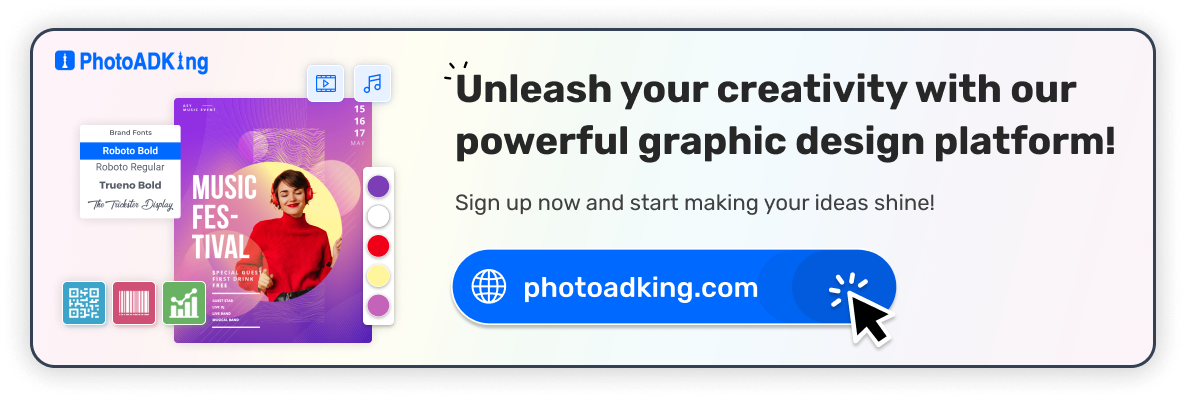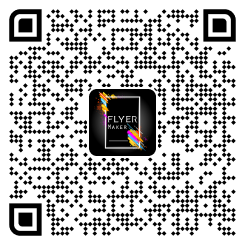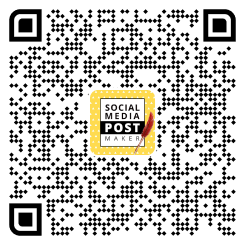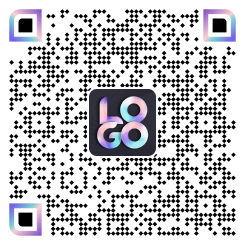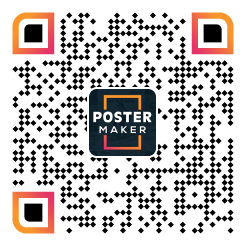Typography is more than just arranging letters on a page. It’s an art form that conveys messages, evokes emotions, and sets the tone for any written content. Types of fonts, also known as typefaces, are designs for sets of characters – letters, numerals, and symbols. They determine the visual style of text, influencing how readers interpret and engage with content.
Fonts are essential not only for readability but also for conveying meaning and aesthetics. This article will delve into the fascinating world of fonts, exploring the origins of old fonts, types, trends of typography, and usage scenarios.
Table of Content
The Evolution of Fonts
Fonts have changed a lot throughout history. It began with simple handwriting-style writing in ancient times. In the middle ages, fonts got fancier. When printing started, more consistent fonts like blackletters were made. During the renaissance, fonts with little lines at the ends (serif fonts) like baskerville became popular.
In the 18th century, fonts like Times New Roman that are elegant and easy to read arrived. Nowadays, we have many fonts, like modern ones without those little lines (sans-serifs) such as Helvetica, and fun ones for special purposes. This happened because of how things looked nice and what worked well for different ways of communicating.
Different Types of Fonts
Let’s uncover the magic of various types of font design styles! Discover different types of fonts for every design need. Dive in!
1. Serif Fonts
Serif fonts are a timeless typeface category characterized by the presence of small lines or strokes, known as serifs, at the ends of each letter. Also, serifs, which can be bracketed, slab, or even tapered, contribute to the overall readability and elegance of the font.
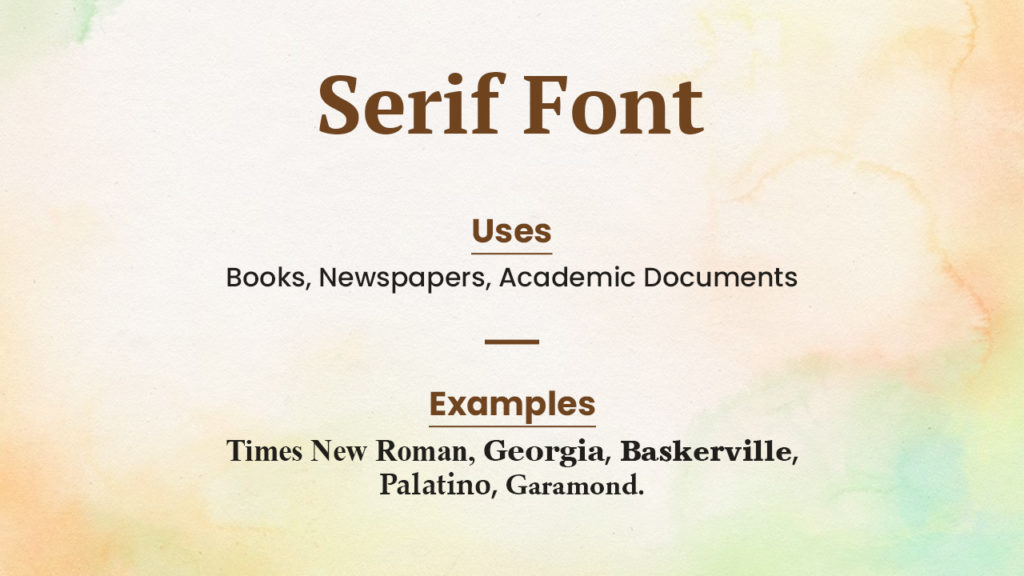
Furthermore, the serifs serve the purpose of guiding the reader’s eye along the text. Making it easier to read longer passages. Besides, due to their formal and classic appearance, serif fonts are often selected for printed materials. Such as books, newspapers, and academic documents.
Examples of Serif fonts include Times New Roman, Georgia, Palatino, Garamond, and Baskerville.
2. Sans-Serif Fonts
Sans-serif fonts, as the name suggests, lack the embellished serifs seen in serif fonts. Moreover, that design is characterized by clean and straightforward lines, creating a modern and minimalistic aesthetic.
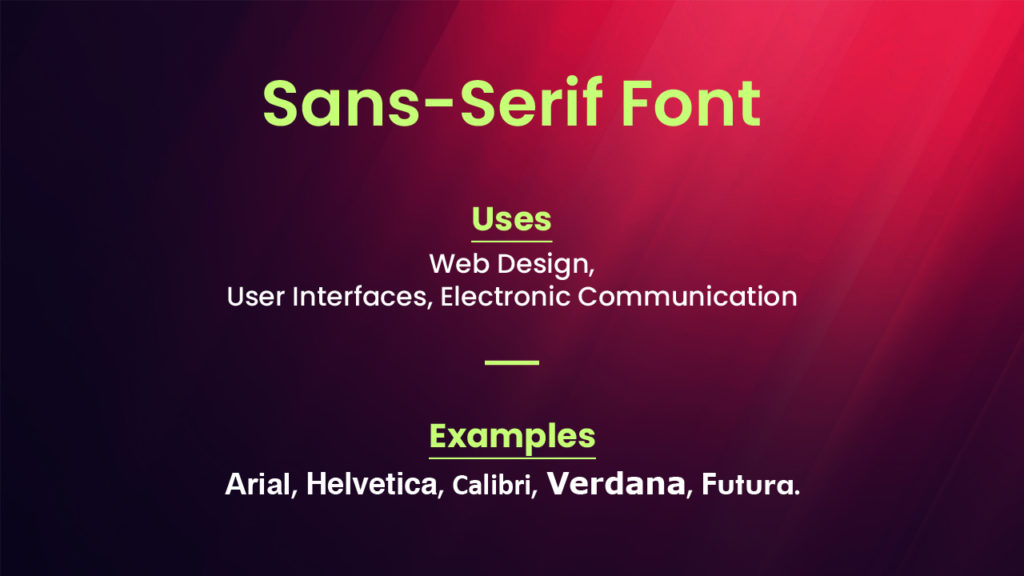
Moreover, the absence of serifs enhances legibility, especially on digital screens. Where the resolution might be lower. This quality has led to the widespread use of sans-serif fonts. Such as web design, user interfaces, and electronic communication.
Examples of sans serif fonts include Arial, Helvetica, Calibri, Verdana, and Futura.
3. Slab Serif Fonts
Slab serif fonts are typefaces characterized by their thick and bold letterforms. It features distinct Slab serif fonts that take the concept of serifs to a bolder level. With thick, block-like serifs attached to each letter. They exude a strong and commanding presence.
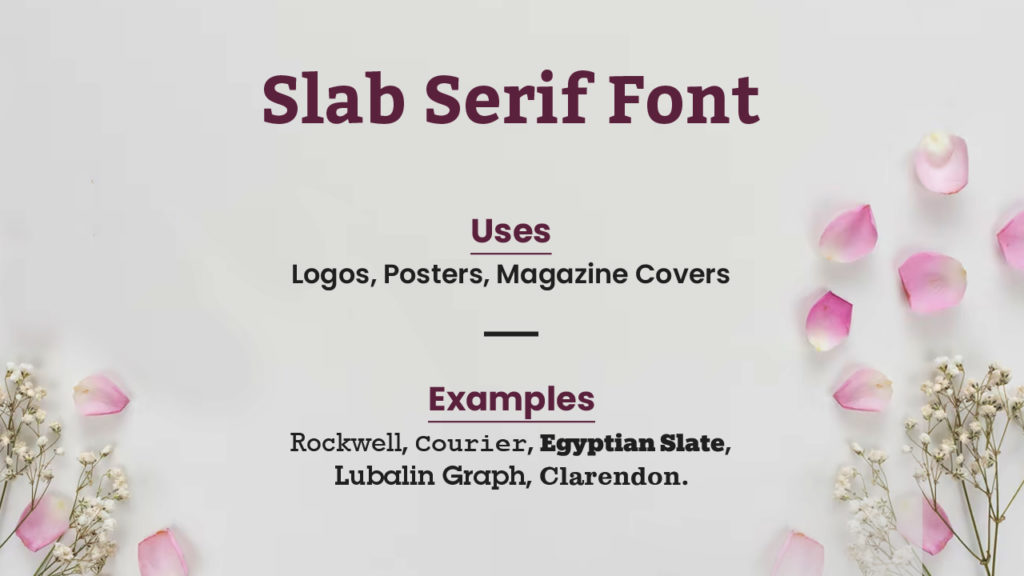
In addition, their high contrast between thick and thin strokes gives them a distinct visual impact, making them a popular choice for attention-grabbing headlines in both digital and print media. Also, logos, posters, and magazine covers often benefit from the striking nature of slab serif fonts.
Examples of slab serif fonts include Rockwell, Courier, Egyptian Slate, Lubalin Graph, and Clarendon.
4. Script Fonts
Script fonts mimic the fluidity and connectedness of handwritten calligraphy. These fonts use natural handwriting, with letters flowing into one another. Hence, examples of font style script add a touch of elegance, warmth, and personalization to designs.
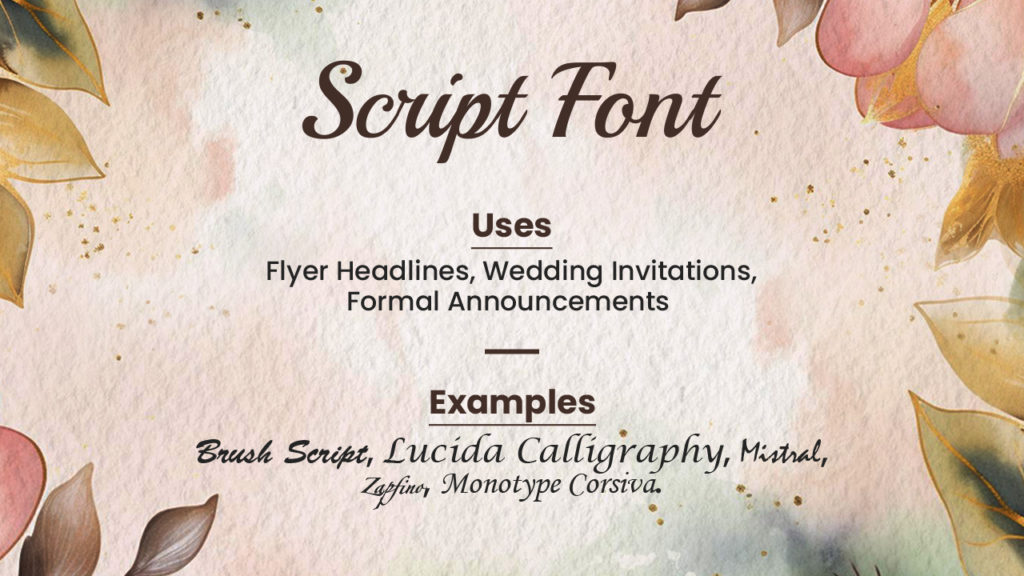
They are commonly used for flyer headlines, wedding invitations, formal announcements, and any context where conveying a sense of intimacy or artistic flair is desired.
But if you want a font that looks really nice on a flyer, think about using script fonts. They can make the flyer artistic. To make things even easier, you can try a flyer maker tool. It helps you make your flyer look good without any trouble.
Examples of script fonts include Brush Script, Lucida Calligraphy, Mistral, Zapfino, and Monotype Corsiva.
5. Display Fonts
Display fonts are designed to make a statement. They deviate from the norms of type design to offer unique and attention-grabbing styles.
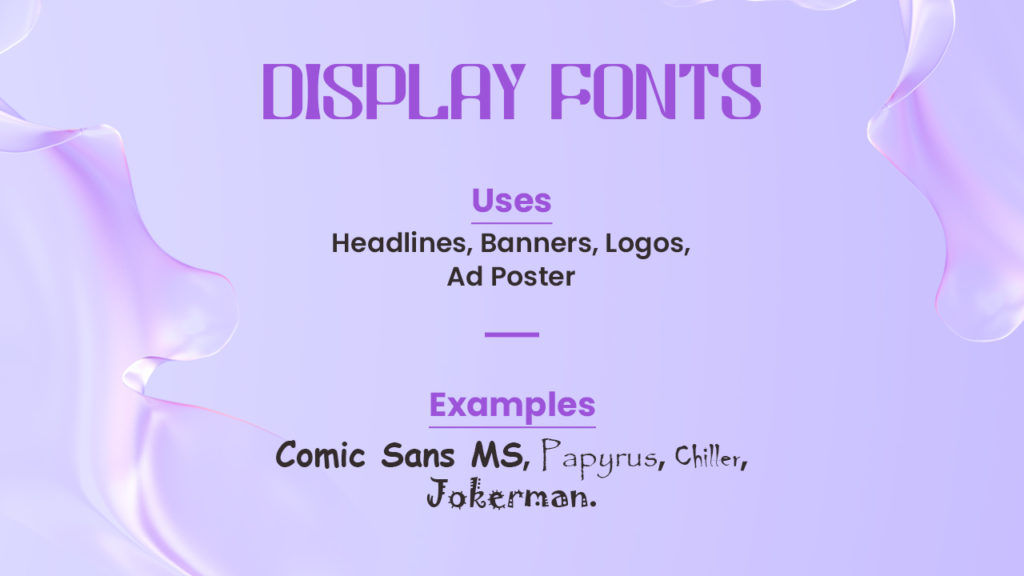
In fact, they encompass a wide spectrum of forms – from the extravagant and ornate to the quirky and playful. Also, their primary role is to add a burst of visual interest to headlines, banners, logos, and other eye-catching elements in designs.
Examples of display fonts include Comic Sans MS, Impact, Papyrus, Chiller, and Jokerman.
6. Handwritten Fonts
Handwritten fonts replicate the organic irregularities of human handwriting, lending authenticity and individuality to text. As a result, they establish a personal connection between the content and the reader.
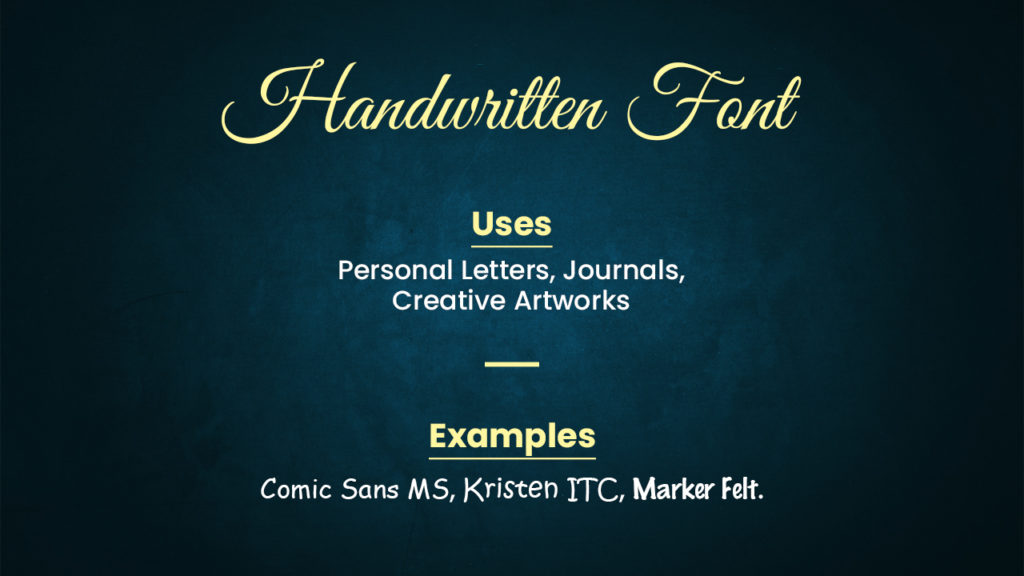
These fonts are often used in projects where a personal touch is essential, such as personal letters, journals, or creative artworks, instilling a sense of familiarity and warmth.
Examples of handwritten fonts include Comic Sans MS, Kristen ITC, and Marker Felt.
7. Monospaced Fonts
Monospaced fonts, also known as fixed-width or typewriter fonts, adhere to a strict grid where each character occupies the same amount of space. Indeed, this uniformity is particularly valuable in coding and programming environments.
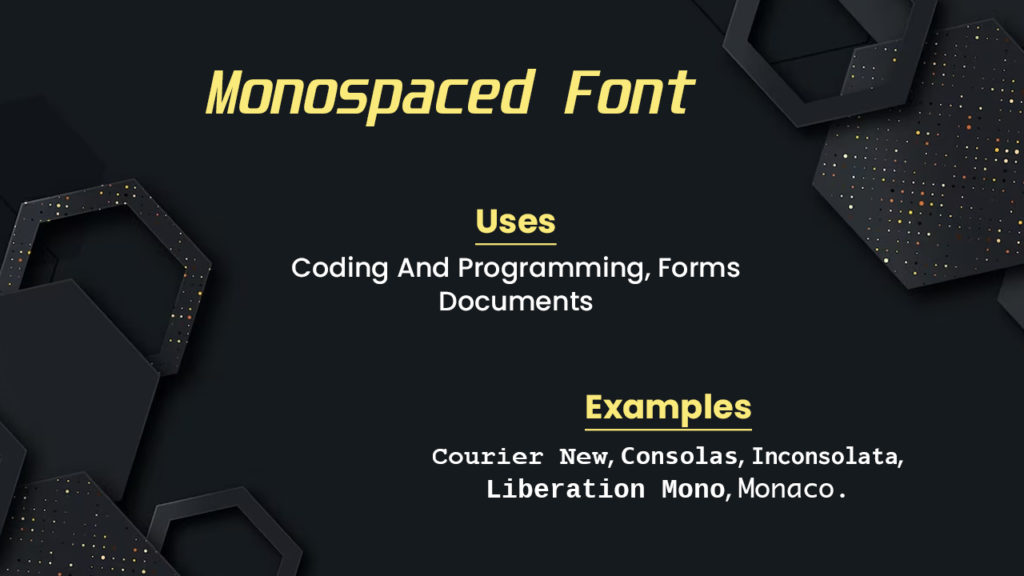
When lines of code align perfectly, the code becomes more readable, aiding programmers in spotting errors and maintaining consistency. Used in coding and programming, creating forms, tables, and documents that require precise alignment of text and numbers.
Examples of monospaced fonts include Courier New, Consolas, Inconsolata, Liberation Mono, and Monaco.
8. Decorative Fonts
Decorative fonts encompass a diverse array of unconventional designs that break away from traditional typefaces. In addition to their visual appeal, these fonts contribute to the overall theme and mood of a design.
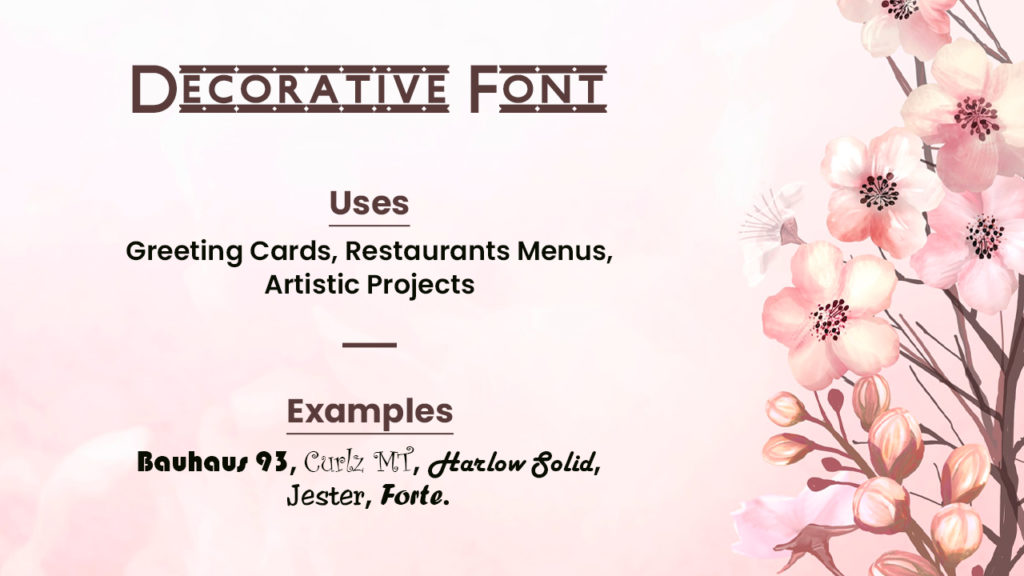
From whimsical and playful to edgy and futuristic, decorative fonts are versatile tools for conveying creativity and uniqueness in design projects. Use in such as greeting cards, restaurants menus, and artistic projects
Examples of decorative fonts include Bauhaus 93, Curlz MT, Harlow Solid, Jester, and Forte.
9. Modern Fonts
Modern fonts, often referred to as Didone or Neoclassical fonts, are characterized by high contrast between thick and thin strokes, along with vertical stress. In conclusion, their refined and elegant appearance makes them ideal for conveying a sense of sophistication and luxury.
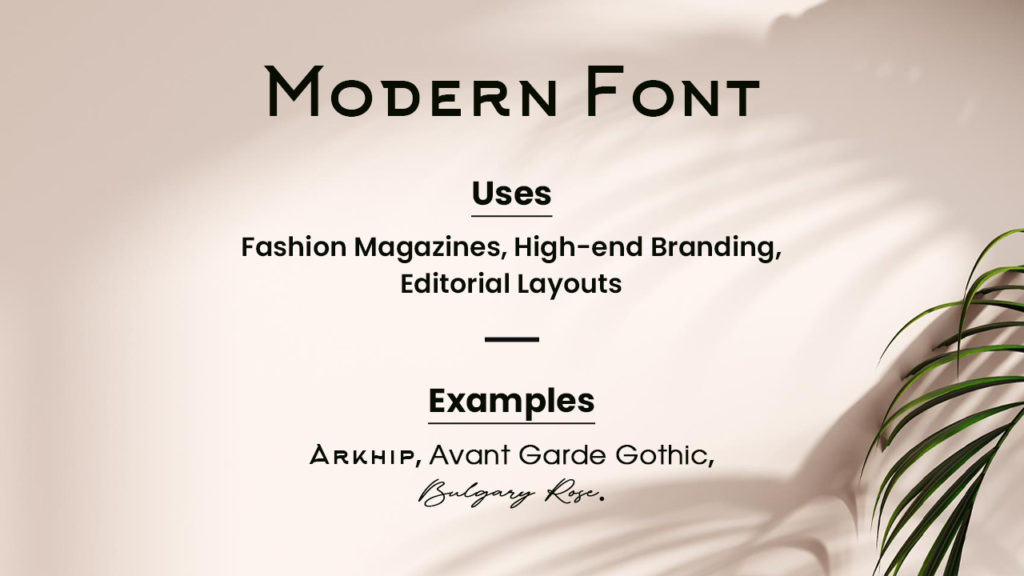
Fashion magazines, high-end branding, and editorial layouts frequently incorporate modern fonts to evoke a sense of timelessness and class.
Examples of modern fonts include Futura, Avant Garde Gothic, and Century Gothic.
10. Blackletter Fonts
Blackletter fonts harken back to medieval manuscripts and the art of calligraphy with their intricate and ornate design. Thus, they exude a sense of tradition and historical depth.
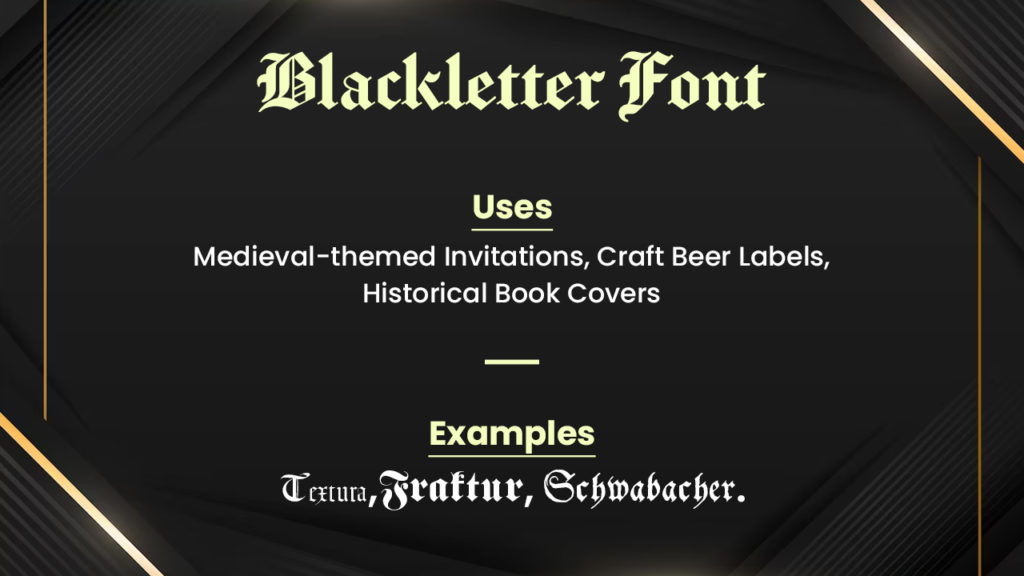
While less common in contemporary designs, blackletter fonts are used deliberately to evoke a sense of reverence or to establish a connection to the past. Use in such medieval-themed invitations, craft beer labels, and historical book covers.
Examples of blackletter fonts include Textura, Fraktur, Schwabacher, and Rotunda.
11. Calligraphic Fonts
Calligraphic fonts are like fancy handwriting. Also, they have smooth, artistic lines that look like a talented calligrapher wrote them. These fonts make each letter look beautiful, adding a classy and handmade feel to your projects.
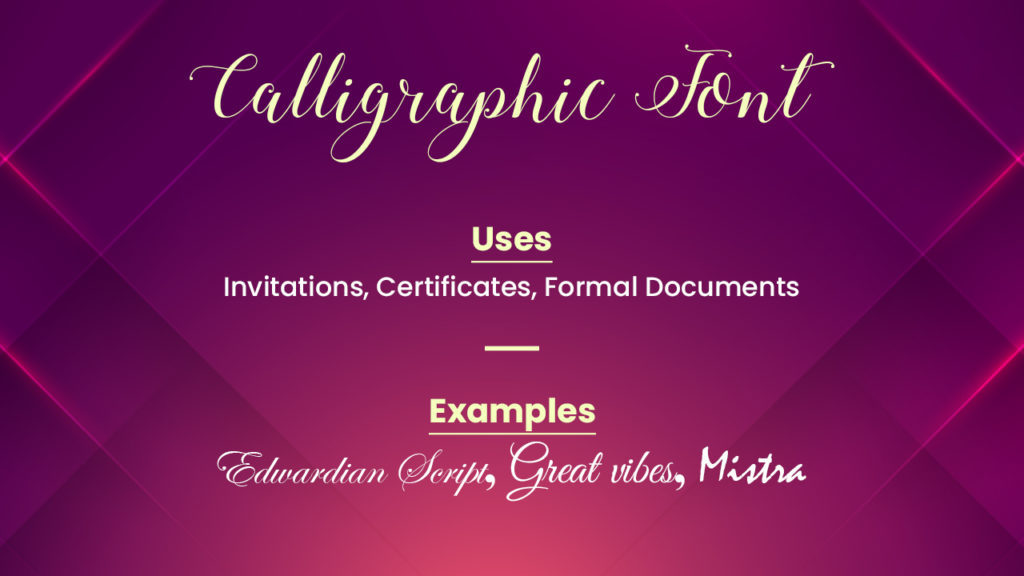
Moreover, Invitations, certificates, and other formal documents often benefit from the intricate charm of calligraphic fonts.
Examples of calligraphic fonts include Edwardian Script, Lucida Calligraphy, Mistra, and many more.
Future Trends in Typography
Variable Fonts
Variable fonts are like magic font files that can change their style and weight. This helps designers make things look cool on different devices. As the internet and gadgets rule, these fonts will get even more famous for being awesome on all screens!
Augmented Reality (AR) Typography
AR tech adds digital stuff to the real world using phones and smart glasses. Typography in AR means text you can play with – moves when you do, even in 3D! Makes things feel really fun!
Responsive Typography
Exciting biotech breakthroughs could create fonts that light up naturally! Also, imagine text that changes colors with light, temperature, or touch – the future of typography!
Custom Hand Lettering and Calligraphy
As digital tools become more sophisticated, custom hand lettering and calligraphy could make a comeback, offering a unique and human touch to digital designs.
Algorithmic Typography Generation
Utilizing machine learning and AI, designers could create algorithms that generate unique typefaces or layouts based on specific input parameters, enabling rapid experimentation and customization.
The Influence of Fonts on Branding
Creating a Visual Identity
Fonts play a pivotal role in such as branding, contributing to a brand’s identity and recognition. Companies select fonts that align with their values and offerings.
Establishing Brand Personality
Different font styles design convey different personalities. Also, a playful font might suit a children’s brand, while a sleek font fits a luxury product.
You Might Like These Reads
Best Meme Fonts
Best Fonts for Invitation
20 Best Brochure Fonts
Best Fonts for Flyers
Gift Card Font
Conclusion
Fonts are more than just letters on a screen. They are the unsung heroes of effective communication and design. However, if you’re aiming for elegance, modernity, creativity, or simplicity, the right font choice can make all the difference in conveying your message to the world. By understanding types of fonts, the diverse world of fonts, and their impact, designers, writers, and brands. It can effectively convey messages that resonate with audiences.
FAQs
Fonts can be categorized into several types, including Serif, Sans Serif, Script, Display, and Monospaced. Each type has distinct characteristics that influence the mood and readability of your text.
Fonts influence how readers perceive content, impacting readability and the overall engagement level.
Serif fonts have small decorative lines at the ends of characters, giving them a more traditional and formal look. Sans Serif fonts lack these lines, resulting in a modern and clean appearance.
Variable fonts offer adaptability and reduce the number of font files needed. They provide flexibility in fine-tuning font attributes.
Absolutely! Custom or unique fonts can enhance brand identity. Choose a font that aligns with your brand’s personality and values.
Online font libraries and platforms provide a wide range of fonts to choose from. Some websites offer both free and premium fonts for various design needs.

